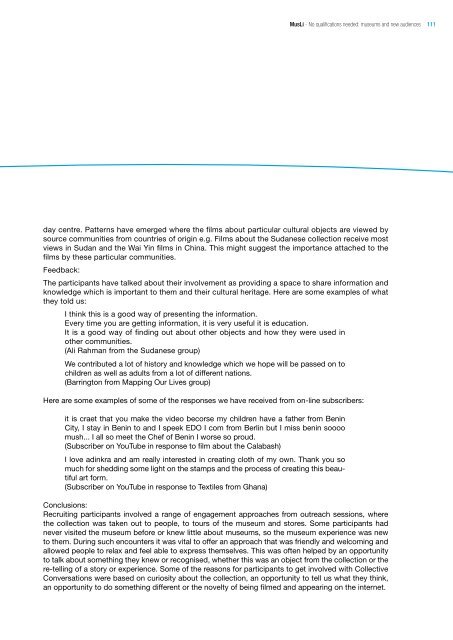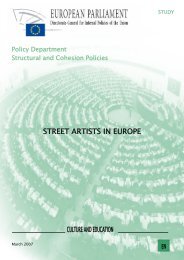MusLi (Museums Literacy) - Fondazione Fitzcarraldo
MusLi (Museums Literacy) - Fondazione Fitzcarraldo
MusLi (Museums Literacy) - Fondazione Fitzcarraldo
You also want an ePaper? Increase the reach of your titles
YUMPU automatically turns print PDFs into web optimized ePapers that Google loves.
<strong>MusLi</strong> - No qualifications needed: museums and new audiences<br />
day centre. Patterns have emerged where the films about particular cultural objects are viewed by<br />
source communities from countries of origin e.g. Films about the Sudanese collection receive most<br />
views in Sudan and the Wai Yin films in China. This might suggest the importance attached to the<br />
films by these particular communities.<br />
Feedback:<br />
The participants have talked about their involvement as providing a space to share information and<br />
knowledge which is important to them and their cultural heritage. Here are some examples of what<br />
they told us:<br />
I think this is a good way of presenting the information.<br />
Every time you are getting information, it is very useful it is education.<br />
It is a good way of finding out about other objects and how they were used in<br />
other communities.<br />
(Ali Rahman from the Sudanese group)<br />
We contributed a lot of history and knowledge which we hope will be passed on to<br />
children as well as adults from a lot of different nations.<br />
(Barrington from Mapping Our Lives group)<br />
Here are some examples of some of the responses we have received from on-line subscribers:<br />
it is craet that you make the video becorse my children have a father from Benin<br />
City, I stay in Benin to and I speek EDO I com from Berlin but I miss benin soooo<br />
mush... I all so meet the Chef of Benin I worse so proud.<br />
(Subscriber on YouTube in response to film about the Calabash)<br />
I love adinkra and am really interested in creating cloth of my own. Thank you so<br />
much for shedding some light on the stamps and the process of creating this beautiful<br />
art form.<br />
(Subscriber on YouTube in response to Textiles from Ghana)<br />
Conclusions:<br />
Recruiting participants involved a range of engagement approaches from outreach sessions, where<br />
the collection was taken out to people, to tours of the museum and stores. Some participants had<br />
never visited the museum before or knew little about museums, so the museum experience was new<br />
to them. During such encounters it was vital to offer an approach that was friendly and welcoming and<br />
allowed people to relax and feel able to express themselves. This was often helped by an opportunity<br />
to talk about something they knew or recognised, whether this was an object from the collection or the<br />
re-telling of a story or experience. Some of the reasons for participants to get involved with Collective<br />
Conversations were based on curiosity about the collection, an opportunity to tell us what they think,<br />
an opportunity to do something different or the novelty of being filmed and appearing on the internet.<br />
111






